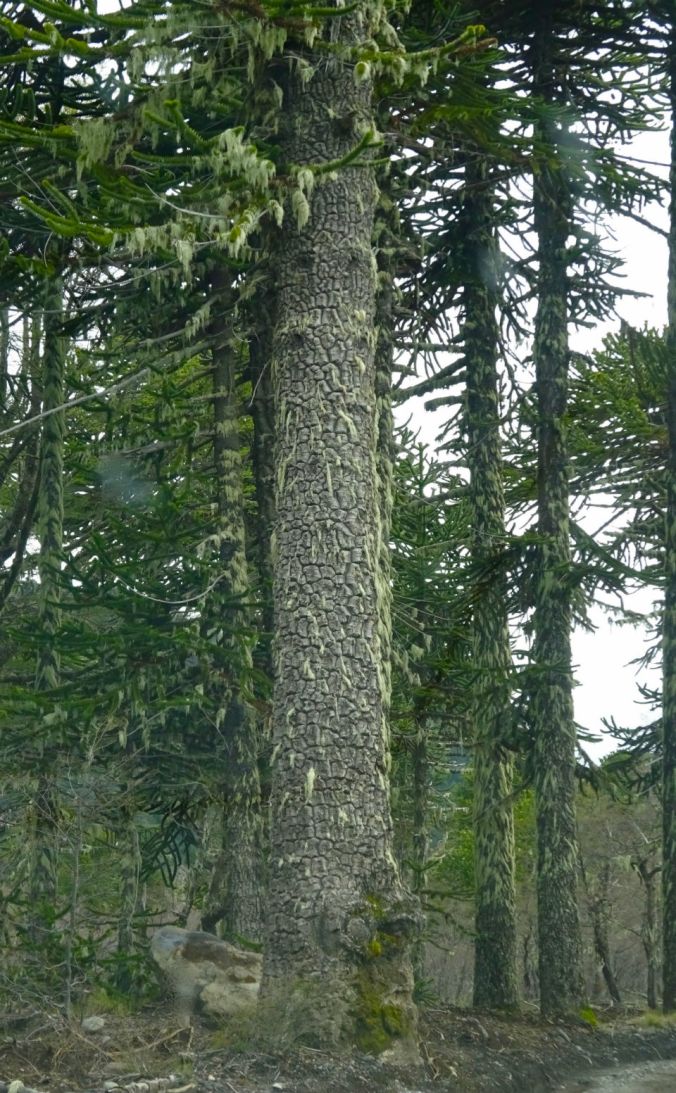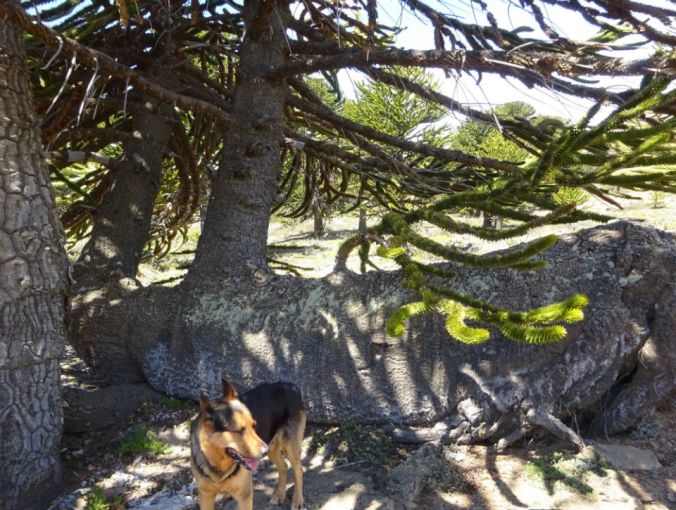With no garden visits planned for November I decided it was the perfect time to go and find my daughter who lives at Pino Hachado, a mountain pass on the Argentinian side of the Andes. Horses and Huskys de los Pehuenes
Situated at least an hour away from any neighbour, windy and arid with not a huge variety of plant species I did not envisage this to be a gateway to a beautiful garden or horticultural delight.

However what I had not expected were the trees. We had approached Argentina from Chile and driving over the Andes we were amazed at the mass of tall, straight trunks of evergreen trees dripping in lichen; Araucaria araucana, the Chilean Pine, known locally as the Pehuen, and to you and me as the Monkey Puzzle tree.

Now, I have to admit that these trees have never been a favourite of mine, almost considering them a joke really, and I remember as a child thinking how out of place a specimen looked in a near neighbour’s cottage garden.
But here in their natural habitat (central and southern Chile and western Argentina) typically growing above 1,000 m (3,300 ft), they are something different; I could not help but become fascinated by them.

Big and unbending many have been around for a very long time, their longevity making them living fossils.

The bark so hard and rough, has developed to be fire resistant. On the inside of the bark it is smooth, and a small piece of this served as a soap dish in my cabin.

Trees can grow to a staggering 50m, shedding their lower branches the umbrella top towers over the younger ones commanding a regal presence.

Whilst Chile claims it as its national tree, the province of Nequen in Argentina has added it to their Coat of Arms.

It first entered our shores in the hands of Archibald Menzies the 18th century plant collector who was commissioned by the Royal Botanic Garden at Kew to collect plants in South America. It is rumoured that when Menzies dined with the Governor of Chile, seeds of the Araucaria araucana were on the menu, and Menzies pocketed some of the seeds, managing to grow five which he then presented to Joseph Banks at Kew in 1795.
It was a few decades later that William Lobb the plant collector, employed by the Veitch’s nursery, introduced the tree commercially and so the tree became popular amongst Victorian gardeners.

And the name “Monkey Puzzle? Well the story dates back to its early cultivation in Britain when the species was still relatively unknown. Sir William Molesworth of Pencarrow in Cornwall purchased a young specimen for 20 guineas and when showing it to a group of friends, Charles Austin, a noted barrister was reputed to have remarked “It would puzzle a monkey to climb that”. Devoid of an existing common name, ‘Monkey puzzler’ became ‘Monkey puzzle’.

The tree is dioecious; male and female cones grow on separate trees, although very occasionally individual specimens can bear cones of both sexes.
Pollinated by the wind, the cones of the male are smaller than the female, oblong in shape they expand at pollen release.

The female (seed) cones are larger and more rounded, maturing in autumn about 18 months after pollination.

Trees do not yield seeds until they are 30 to 40 years old and the cone holds about 200 seeds, disintegrating at maturity…

to release edible nut-like seeds known locally as pinones.
Preferring well-drained slightly acidic soil, saplings pop up in the volcanic ground; this little chap appears to be mimicking a monkey with its arms out-stretched with upright tail.

Developing into a broadly pyramidal or conical shape, growth is very slow and these trees are actually several years old.

If a trunk falls, life just seems to carry on.

It is amazing to see them just growing out of rock, surviving on apparently little,

no wonder perhaps that they are considered sacred to some members of the local Mapuche Native tribe,

The roots are quite superficial even appearing sometimes above ground; crocodilian, old and gnarly,

they have the ability to sprout new shoots growing some distance away from the tree.

On this high terrain the wind blows strong and whether it is due to this, the arid conditions or simply old age, the end of the branch eventually turns brown, breaks off and a milky white sap oozes forth,

and sharply pointed brown leaves carpet the ground.

Back in the cabin the trees continue to remind of us of their existence; a beautiful old stump turned into a stool seems to have acquired some anthropomorphic traits.
However, once valued for its long straight trunk, and its now vulnerable status, the timber became protected by law in 1971 and is now rarely used.

Stopping at a pizzeria one day I could not resist the opportunity of sampling the Araucaria pizza ……it looked and smelt delicious…

…without going into detail it was something I very much regretted!
Pine nuts are not the only product of the tree; Jet is the result of high-pressure decomposition of the wood and the Jet found at Whitby, North Yorkshire (Whitby Jet) is the early Jurassic fossilized wood of the same species Araucaria araucana.

Although not a garden as such, the gates to Pino Hachado, opened up a new world, an eye-opening view of a species growing in its natural habitat. Surrounded by these huge old giants growing for so many years and in such difficult conditions, I realised that the Monkey Puzzle tree was not so much a joke, but a really intriguing species for which I now have a new-found respect.

——-10/18——-


Fascinating!
Looking forward to hearing more about it
Sent from my iPhone
LikeLike
Well, a tree that has puzzled me since my suburban childhood has now been explained… even its sex life and the so very unexpected link to jet and Whitby. Great photos especially the last and I have learnt a new word, too, ‘dioecious’. Thank you… all fascinating.
LikeLike
Thank you and ‘dioecious’ is a great word
LikeLike
I agree that in their natural habitat these trees are quite different. I enjoyed reading about them…so much I didn’t know. The last photo of the sentinel tree is wonderful.
LikeLike
Truly fascinating, Julia, and so unlike our own dear Norfolk. Reggie.
LikeLike
Fascinating.
Love your photos.
Looks like you’re having a wonderful trip..
LikeLike
Sounds an amazing trip and loved all the pictures showing the tree in its natural habitat. Fascinating Julia, thanks.
LikeLike
Facinating and much enjoyed by Richard and I .Thank you.
LikeLike
What a great blog and great pictures too. The final one is fabulous.
You’ve certainly added tommy knowledge. Thank you
LikeLike
Another outstanding blog , with amazing photographs . Truly educational too.
What a wonderful world .
LikeLike
I have a wooden bowl made out of monkey puzzle. The four branches are all in the same horizontal line and start at the same point. There is an interesting avenue ( or line of trees ) on the Le Strange estate at Hunstanton with a lot of regeneration surrounding each tree. Love John
LikeLike
So impressed by your initiative in profiling this tree in the absence of beautiful gardens! Brilliant!
Learned such a lot from your research and the photos are terrific. Thanks for sharing.
LikeLike
I had never liked these trees before. You have won me over by showing them in their natural habitat. Isn’t that the way with a lot of plants?! Those roots are amazing. I can see why you would use the timber. They are so straight and tall. I bet the grain is gorgeous.
LikeLike
How amazing to see this tree in its native habitat ! Not one of my favourites either but in the wild fabulous! A wonderful trip by the sounds of it! X
LikeLike
I recently read (in Thomas Pakenham’s book ‘The Company of Trees’) that the monkey puzzle tree is known as Monkey’s Despair in French! Very appropriate!
LikeLike
What fun to have an international angle on garden reporting…and that pizza sounded delicious – how could it have been so awful?! Love to all.
LikeLike
Fantastic-I did enjoy this ! I actually love these trees,but did not know much about them-but I do now ..
What a wonderful trip .
LikeLike
Fascinating! Thank you very much for sharing this interesting information and your amazing photos.
LikeLike
Fascinating, thank you! Love Sally
Sent from my iPad
>
LikeLike
Hi Julia … thanks for another great blog post. A surprise from so far afield and really interesting. You have such a good eye for images, as well as your skill with words. I loved your creative interpretation of the ‘little monkey’! Enjoy the rest of your holiday and safe travels.
LikeLike
Once again you have taken some wonderful photos and given me so much new information – I will now have a new respect whenever I see a Monkey Puzzle
Love Fiona
LikeLike
I love this Museum. I had a picnic lunch in the shady garden after looking around, although the restaurant does look good. Last year there was a wonderful exhibition of the Flower Fairy watercolour paintings. The view from the tower is worth the climb too.
R
LikeLike
Perhaps we should meet there for lunch?
LikeLike